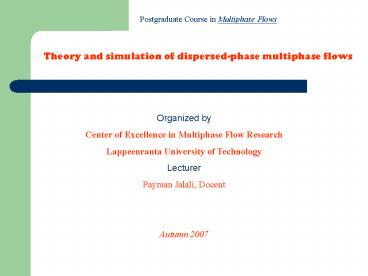Theory and simulation of dispersedphase multiphase flows - PowerPoint PPT Presentation
1 / 17
Title:
Theory and simulation of dispersedphase multiphase flows
Description:
Theory and simulation of dispersed-phase multiphase flows ... Using the Darcy-Weisbach friction factor for the fluid and substituting it in ... – PowerPoint PPT presentation
Number of Views:83
Avg rating:3.0/5.0
Title: Theory and simulation of dispersedphase multiphase flows
1
Postgraduate Course in Multiphase Flows
Theory and simulation of dispersed-phase
multiphase flows
Organized by Center of Excellence in Multiphase
Flow Research Lappeenranta University of
Technology Lecturer Payman Jalali,
Docent Autumn 2007
2
Numerical Modeling
- Numerical simulations can be basically divided
into dilute and dense flows. - Dilute flows - Lagrangian models
- In dilute flows particle and droplet motion is
controlled by the hydrodynamic forces on the
dispersed phase elements. First,
quasi-one-dimensional flows will be addressed
followed by more general multidimensional flows.
Two formulations exist primitive variable and
conservative variable. The latter is advantageous
in compressible flows which will not be discussed
here. - We consider quasi.one-dimensional flows, which
were formulated in lectures 6 and 7. These
equations are expressed in terms of the primitive
variables (flow velocities, pressure, and
temperature).
3
Numerical Modeling
Primitive variable formulation (single-phase
flow) First, consider the steady flow of an
inviscid fluid in a tube shown below. The
momentum equation will then be
A central difference scheme for both derivatives
can lead to trivial solutions (constant velocity
and pressure) as well as other unacceptable
saw-tooth solution for pressure. This leads us
to the introduction of the staggerred grids where
the nodes of velocity lies between the nodes of
pressure.
4
Numerical Modeling
The finite difference equation for velocity then
becomes
The inconsistency of the conventional grid is
avoided with this grid system. Therefore, in the
rest of formulations we prefer to select the
staggerred grid system rather than the
conventional grid.
5
Numerical Modeling
Now, consider the steady flow in a duct to
introduce the ideas behind the primitive variable
formulation. Pressure is known at each end of
the duct, and the distribution of the
cross-sectional area is known through the duct.
The fluid is incompressible. Note to the
pressure nodes and velocity nodes, which define
momentum and continuity cells, respectively.
6
Numerical Modeling
The continuity equation was In the absence of
the dispersed phase, it changes to
The momentum equation with the dispersed phase
was
7
Numerical Modeling
Using the Darcy-Weisbach friction factor for the
fluid and substituting it in the momentum
equation and solving for the velocity at node i1
gives
We can create an iterative scheme in which
velocity and pressure are related. The Taylor
series expansion is used to express the velocity
difference (at i1) between the two successive
iterations to the pressure differences (at i and
i1). The derivatives of velocity with respect
to the pressure are obtained from the above
equation. The subscript represents the values
from the previous iteration. Thus the new
velocity can be expressed as a function of the
previously calculated velocity and the pressure
change by
8
Numerical Modeling
Similarly, for node i we have
These expressions for velocity are substituted
in the continuity equation, which yields
In this problem the pressure at the beginning
and end of the nozzle are fixed so ?p1 and ?pN
are zero. This results a tridiagonal system of
algebraic equations which may be solved using the
TDMA. The right-hand side is the continuity
equation which is zero when it is
satisfied. Conclusion The last-mentioned
equation corrects the pressure field in a
direction to satisfy the continuity equation.
Once the continuity equation is satisfied, the
pressure changes are zero and no further
correction is needed. The reformulation of the
continuity equation in terms of pressure is
called the SIMPLE method (Semi-Implicit Method
for Pressure-Linked Equations)
9
Numerical Modeling
Here, ? is the relaxation factor (usually 0.5).
The new velocity field from this equation becomes
ui field in the equation for pressure change.
10
Numerical Modeling
3- If the continuity is satisfied? The
convergence criterion is the satisfaction of the
continuity equation as
4- If the convergence is not achieved, use TDMA
or other methods to obtain pressure changes using
11
Numerical Modeling
5- Velocities are corrected then
6- Return to step 2 and continue until the
convergence is achieved.
12
Numerical Modeling
Primitive variable formulation (multiphase
flow) Consider the fluid-particle flow in the
nozzle shown below. The fluid is
incompressible. The continuity equation is
N is the number of droplets in the control
volume. The momentum equation for the
quasi-one-dimensional flow of the carrier phase
with the suspended droplets is
13
Numerical Modeling
The source term can be expressed as
- The solution procedure is more or less similar to
single-phase flow. Here is the flow chart of the
procedure with the steps - First, a velocity and pressure field are assumed
throughout the nozzle. - The particle velocity equations are then
integrated to provide the fluid volume fraction
and the parameters in the momentum source term
14
Numerical Modeling
15
Numerical Modeling
3) The volume fraction and source terms in the
momentum equation can be determined.
4) The continuous phase velocity is calculated
from the recursion formula
16
Numerical Modeling
5) The pressure form of the continuity is used to
correct pressures
6) Correct pressure and velocity and return to
step 2 until convergence.
17
Numerical Modeling
The relation between old and new velocities is
obtained from the Taylor series
Use this equation to find derivatives
Resulting equation is used for velocity
correction. Note that the above-mentioned
procedure includes two-way coupling.

